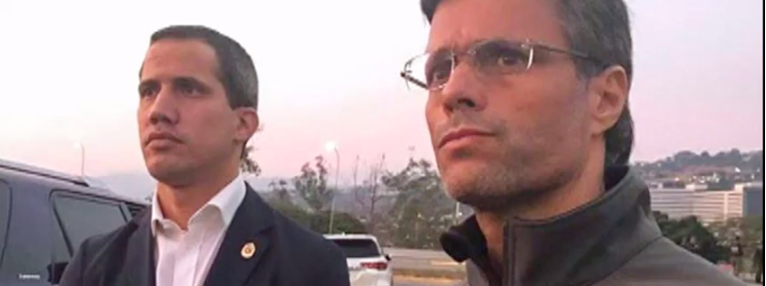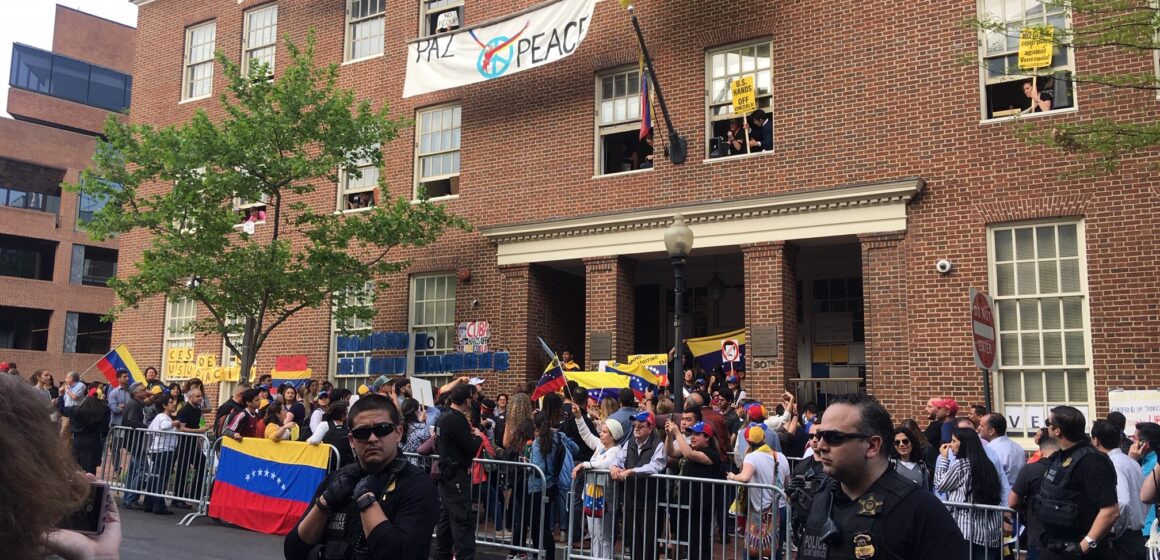
When Manuel Figuera, the chief of the Venezuelan intelligence service (SEBIN), turned on the government of President Nicolas Maduro last week, the Trump administration thought their goal of regime change was in sight. If Figuera joined opposition leader Juan Guaidó’s government in exile, SEBIN could both control the country and secure recognition of Washington.
With Figuera on board, Secretary of State Mike Pompeo believed that the Venezuelan security forces would join with Washington and 53 nations in recognizing Guaidó as president. (The United Nations and 100-plus other countries recognize Maduro.) They imagined they were on the brink of victory.
There were the makings of a deal, according to credible news reports. The existence of a 15-point plan was independently reported on Venezuelan TV, in the Guardian and on Univision. It wasn’t denied by the Maduro government nor the participants, including Venezuelan Defense Minister Vladimir Padrino, who all but confirmed he was in contact with U.S. interlocutors. Uninterested in staging a coup, the officer corps is open to solutions from the international community, according to the International Crisis Group (ICG), an independent think tank that seeks to influence U.S. policy. With the country suffering hyperinflation and food shortages, the political pressure will build to act.
“When the military high command sees the cost of giving in to external pressure as lower than the cost of keeping internal peace and order, then they are likely to act,” said one government source cited by ICG.
A possible national compromise was under discussion last week, according to credible news reports. Trump’s special envoy, Elliott Abrams, spoke of a 15-point plan involving guarantees for the military and intelligence services (which have been accused of many human rights abuses), a dignified exit for Maduro, the installation of Guaidó as interim president, the preservation of the current Supreme Court and the high command, and new elections within 12 months.
Abrams, a veteran of a U.S. regime change operation in Nicaragua in the 1980s, has plenty of experience in coordinating propaganda and covert operations. In Nicaragua, his agents perpetrated and covered up massive human rights abuses.
As described, the 15-point plan was a good deal for the armed forces (blocking prosecution for abuses) with a big concession to Chavistas (giving them the Supreme Court). It might, emphasis on the conditional, have been the basis for a consensual solution. (Some commentators have speculated about a Cuban or Russian counterintelligence operation to smoke out Maduro’s opponents, which is possible but not confirmed.)
In any case, the U.S.-backed opposition spurned it. On April 30, Guaidó, a political novice, went public with a call for an uprising against Maduro. He appeared outside a military based with his mentor, Leopoldo Lopez, the former opposition leader who had been under house arrest and called for the people to rise up.
That’s when the uprising started doing south. Lopez, who flirted with supporting the failed 2002 coup against President Hugo Chavez, is too closely associated with the country’s wealthy elite to lead a broad-based movement against Maduro.The fractious opposition is actually less popular than Maduro’s ruling party, according to one November 2018 poll, not the least because of its stated goal of privatizing the state oil company. The prospect of a new Guaido government dominated by Lopez was a non-starter to the Venezuelan officer corps.
“Those close to the talks said the two men’s call for an uprising broke confidence with the regime negotiators, who then pulled out of the pact,” according to the Wall Street Journal.
The uprising fizzled. The officials who had talked about breaking with Maduro backed off and embraced the government. Padrino, the defense minister; Gen. Ivan Hernández, head of military counterintelligence; and Gen. Jésus Suárez Chourio, head of the army all appeared with Maduro on Thursday as he gave a speech to troops at a military base in Caracas, according to the Journal,
“They’re trying to buy us off as if we were some kind of mercenaries,” Padrino said, standing next to Maduro. “Those who have fallen for that, fallen into selling their soldier spirit, cease being soldiers and, of course, can’t be among us.”
Pompeo, the former CIA director, all but admitted the U.S. had sought to purchase the loyalty of the Venezuelan officers. When a Univision reporter asked Pompeo on Friday “if the U.S. was offering money in exchange for defection,” he replied, “we never talk about the activities we’re in engaged in.”
Figuera vanished into exile (perhaps with U.S. taxpayer dollars in his bank account). Lopez took refuge in the Chilean and then the Spanish Embassy. Pompeo declared the U.S. would take military action, “if required.”
But when Bolton and Pompeo demanded more aggressive military plans, the Washington Post reported that one U.S. general argued intervention was risky and “slammed his hand down on the table” to make his point.
To save face, Guaidó arranged an interview with a friendly Post reporter in which he admitted “mistakes” and welcomed Pompeo’s talk of military intervention.
“That’s great news to Venezuela because we are evaluating all options,” Guaidó said. “It’s good to know that important allies like the U.S. are also evaluating the option. That gives us the possibility that if we need cooperation, we know we can get it.”
Spin aside, it was a disastrous performance—“amateur hour” in the words of John Feeley, former U.S. ambassador to Panama. Feeley, who quit the Foreign Service rather than serve Trump, writes on Univision’s website that Guaidó’s forces had failed in February to deliver humanitarian aid from the Colombian border.
“The events of April 30 leave Guaidó’s team 0 for 2 in terms of dislodging Maduro and his loyalists from Miraflores Palace,” writes Feeley.
Why They Failed
Regime change operations depend on confidence and credibility to succeed. The Venezuelan opposition now has a bigger deficit of both counts than it had a week ago.
Guaidó, who had little going for him save his fresh face, now all but admits he needs the U.S. military to bail him out. Lopez, more divisive than ever, is effectively sidelined again. Maduro, more defiant than ever, has consolidated the security forces behind the survival of his government. And the idea that the United States could forge a solution acceptable to the Venezuelan military and people is open to doubt.
The misplaced confidence of the Trump troika of Pompeo, Bolton, and Abrams was founded in a deep faith in the “regime policies” that the CIA and the U.S. national security have pursued over the last 75 years. The policy tools of “regime change” operations have varied from country to country but not much.
The U.S. intervention in Venezuela has distinctive features—but the template is familiar to anyone who knows the history of U.S.-backed coups in Iran (1953), Guatemala (1954), Brazil (1964), Indonesia (1965), Chile (1970), Nicaragua (1981), Panama (1989), Iraq (2003), and Honduras (2009).
These interventions have had consistently disastrous long-term consequences. Because of the 1953 coup, the Iranian government regards America as “the great Satan.” Guatemala, which had a functioning democracy in 1954, is a failed narco-state. Brazil gained a dictatorship, which lasted a decade (and is now praised by Trump’s far-right ally President Jair Bolsonaro). Indonesia’s coup was followed by a bloodbath that killed thousands. Ditto for Chile. As for Iraq, the criminal folly of regime change needs no explication. The failure of regime change in Libya is ongoing.
Rachel Maddow may be innocent of this bloody record, but you can be sure Venezuelan decision-makers (and their Cuban advisers) are not.
In every case, U.S. policy has moved up the ladder of escalation defined by the “Seven Rules of Regime Change.” Historically speaking, U.S. regime change policy seeks to:
- isolate the targeted regime diplomatically;
- impose sanctions to impose pain on the regime’s constituents;
- publicize and exacerbate the resulting humanitarian crisis;
- recruit local allies with bribes and subsidies;
- solicit domestic support of U.S. liberals with appeals to humanitarianism and democracy promotion;
- generate propaganda about the involvement of ‘foreign’ anti-U.S. forces;
- promise U.S. financial support to any and all factions that abandon the targeted regime.
And, if these measures fail to fracture the unity of the targeted regime, the U.S. then applies selective and, if necessary, overwhelming U.S. military force to achieve its goal.
If the news reports are accurate, the 15-point plan might have offered an off-ramp to war. It wasn’t taken. Now Pompeo is talking about a “full range of options,” which signals a doubling down on a policy that has failed twice. When it comes to “regime change,” U.S. policymakers have forgotten nothing and learned nothing.



